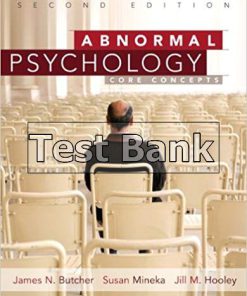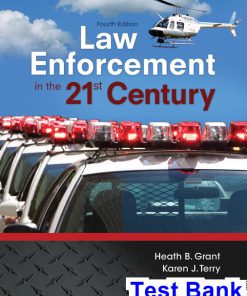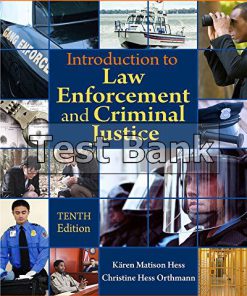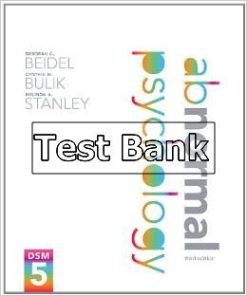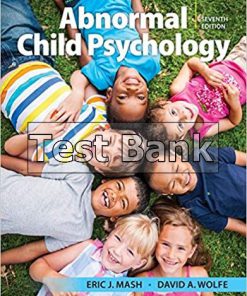Multicultural Law Enforcement 6th Edition Shusta Test Bank
You may also like
-
$26.99
$50.00
Multicultural Law Enforcement 6th Edition Shusta Test Bank

Product details:
- ISBN-10 : 0133483304
- ISBN-13 : 978-0133483307
- Author: Shusta M.P.A., Robert M.; Levine M.A., Deena R.
Multicultural Law Enforcement: Strategies for Peacekeeping in a Diverse Society, 6e is designed for use in criminal justice and social/behavioral science courses, as well as law enforcement in-service training classes and police academies. The textbook is also directly applicable in colleges, university and vocational programs offering emergency services for: police, fire and rescue, emergency medical, emergency management, 911, military as well as civil emergency services.
This comprehensive, student-friendly text, like no other on the market, is designed for students who will become part of a diverse workforce and who, in their future careers, will encounter citizens from many backgrounds.
Table contents:
- Part One Impact of Cultural Diversity on Law Enforcement
- Chapter 1 Multicultural Communities Challenges for Law Enforcement
- Learning Objectives
- Outline
- Introduction
- The Interface of Diversity and Law Enforcement
- The Melting Pot Myth and the Mosaic
- Reactions to Multiculturalism: Past and Present
- Changing Population
- Minority Populations
- Immigrants and Refugees
- Unauthorized Immigrants and Related Terminology
- Further Distinctions between Immigrants and Refugees
- Anti-Immigrant Sentiment
- Community Policing Outreach to Immigrants and Refugees
- Typology of Immigrants and Refugees
- Typology of Immigrant, Refugee, and Minority Individuals
- European Americans
- Unauthorized Immigrants: Demographic Information
- Unauthorized Immigrants: Background Information
- Unauthorized Immigrants: Fear of Deportation
- Unauthorized Immigrants: The “U” Visa and the Safe Reporting of Crimes
- Immigrant Women: Victims of Domestic Violence
- Immigrant Barriers to Positive Relationships with Police
- Culture and its Relevance to Law Enforcement
- The Definition of Culture
- Mini Case Studies and Cultural Practices: Does Culture Matter?
- 1. Culture Matters? The Sword in a Public Park
- 2. Culture Matters? The Turban and the Kirpan
- 3. Culture Matters? A Tragic Case of Cross-Cultural Misinterpretation
- 4. Culture Matters? Latino Values as a Factor in Sentencing
- Dimensions of Diversity
- Primary Dimensions of Diversity
- Secondary Dimensions of Diversity
- Further Diversity within and among Ethnic Groups in the United States
- Prejudice in Law Enforcement*
- Prejudice and Bias
- How Prejudice Influences People
- Peer Relationships and Prejudice
- Summary
- Discussion Questions and Issues
- References
- Chapter 2 The Changing Law Enforcement Agency A Microcosm of Society
- Learning Objectives
- Outline
- Introduction
- Changing Workforce
- Law Enforcement Diversity: A Microcosm of Society
- Racism Within the Law Enforcement Workforce
- Defusing Racially and Culturally Rooted Conflicts
- Conflict Resolution Tips
- Departmental General Order for Control of Prejudicial Conduct
- Police Fraternal Organizations
- Assignments Based on Diversity
- Women in Law Enforcement
- Women in the Workforce
- Number of Women in Law Enforcement
- Workplace Issues
- Sexual Harassment
- Gender Discrimination
- Role Barriers
- The Brotherhood
- A Double Standard
- Differential Treatment
- Career versus Family
- Mentor and Informal Networking Programs for Women
- The Transition of Women into Law Enforcement
- Sexual Orientation in Law Enforcement
- Policy versus Practice
- Recruitment
- The Controversy
- Differences in Treatment of Gay versus Lesbian Officers
- The Transition of LGBT Individuals into Law Enforcement
- Policies against Discrimination and Harassment
- Statutes and Company Policy Pertaining to Discrimination Based on Sexual Orientation
- Training on Gay, Lesbian, and Transgender Issues
- Domestic Violence in LGBT Relationships
- Gender-Neutral Terminology
- Transgender Policies, Protocol, and Training
- Mini Case Study: How Should This Situation Have Been Handled by the Police Department?
- Support Groups for Lesbian, Gay, Bisexual, and Transgender Officers
- Police Leadership, Professionalism, and Synergy
- Leadership
- Professionalism
- Synergy
- Supervisors, Managers, and the Chief Executive
- Demonstrating Commitment
- Developing Strategic, Implementation, and Transition Management Plans
- Managing Organizational Change
- Developing Police–Community Partnerships
- Providing New Leadership Models
- Summary
- Discussion Questions and Issues
- References
- Chapter 3 Multicultural Representation in Law Enforcement Recruitment, Retention, and Promotion
- Learning Objectives
- Outline
- Introduction
- Recruitment of a Diverse Workforce
- Recruitment Crisis and Trends
- Good economy
- Bad economy
- Turning the Corner
- Recruitment Difficulties
- Age, height, and weight
- Drug use and criminal history
- Education
- Additional factors
- Attracting and Retaining Women and Minorities
- Recruitment Strategies
- Commitment
- Marketing Plan
- Resources
- Social Media Platforms
- Selection and training of recruiters
- Recruiting incentives
- Community involvement
- Military veterans
- Internship, Cadet, Reserve, Explorer Scout, and High School Police Academy Programs
- Selection Processes
- Satisfaction Level of Employees
- Applicant Screening (Employment Standards)
- Hiring in the Spirit of Service
- Examples of Successful Recruiting Programs
- Legal Issues and Affirmative Action
- Mini Case Study: What Would You Do?
- Retention and Promotion of a Diverse Workforce
- Retention
- Leadership
- Mentoring
- Training and Development
- Addressing Bias, Discrimination and Harassment
- Communications
- Performance Evaluation
- Job Descriptions
- Promotion
- Generation Y
- Mini Case Study: How Would You Handle It?
- Summary
- Discussion Questions and Issues
- References
- Chapter 4 Cross-Cultural Communication for Law Enforcement
- Learning Objectives
- Outline
- Introduction
- Language Barriers and Law Enforcement
- Attitudes Toward Limited-English Speakers
- Cross-Cultural Communication in the Law Enforcement Context
- The Influence of Hierarchy and Formality on Communication
- High- and Low-Context Communication
- Cross-Cultural Communication Dynamics
- Using Language or Language Style to Become Just Like One of “Them”
- Walking on Eggshells
- “Some of My Best Friends Are . . .”
- “You People” or the We/They Distinction
- “You Stopped Me Because I’m . . .” or Accusations of Racial Profiling
- Communication Considerations Post-9/11
- Interviewing and Data-Gathering Skills
- Nonverbal Communication
- Male-Female Communication in Law Enforcement
- Summary
- Discussion Questions and Issues
- References
- Part Two Cultural Specifics for Law Enforcement
- Chapter 5 Law Enforcement Contact with Asian/Pacific Americans
- Learning Objectives
- Outline
- Introduction
- Asian/Pacific American Defined
- Historical Information
- Law Enforcement Interactions with Asian/Pacific Americans
- Anti-Asian Federal, State, and Local Laws
- Demographics: Diversity Among Asian/Pacific Americans
- Labels and Terms
- Myths and Stereotypes
- The Asian/Pacific American Family
- Culture Shock and the Asian/Pacific American Family
- The Roles of Family Members
- Children, Adolescents, and Youths
- Asian/Pacific American Family Violence
- Communication Styles of Asian/Pacific Americans
- Key Issues in Law Enforcement
- Underreporting of Crimes
- Asian/Pacific American Community and Law Enforcement Interaction
- Increasing Asian/Pacific American Peace Officers
- Hate Crimes against Asian/Pacific Americans
- Crimes within Asian/Pacific American Communities
- Summary
- Discussion Questions and Issues
- References
- Chapter 6 Law Enforcement Contact with African Americans
- Learning Objectives
- Outline
- Introduction
- Historical Information
- Law Enforcement Interaction with African Americans: Historical Baggage
- Demographics: Diversity Among African Americans*
- Issues of Identity and group identification terms
- Stereotypes and Cross-Racial Perceptions
- The African American Family
- The Roles of Men and Women
- The Single Mother
- Children/Adolescents/Youth
- Language and Communication
- “Ebonics,” or African American Vernacular English
- Nonverbal Communication: Style and Stance
- Verbal Expressiveness and Emotionalism
- Threats and Aggressive Behavior
- Key Issues in Law Enforcement
- Differential Treatment
- Racial Profiling in the African American Community
- Perceptions of Police/Authority Treatment
- Excessive Force and Brutality
- Law Enforcement Interaction with African American Communities
- Victimization: Offenders and Incarceration
- Hate Crimes against African Americans
- African American Women and Police
- Addressing the Needs of the Inner City
- Efforts toward a Positive Relationship between Police and Community
- Summary
- Discussion Questions and Issues
- References
- Chapter 7 Law Enforcement Contact with Latino/Hispanic Americans
- Learning Objectives
- Outline
- Introduction
- Terminology
- Unauthorized Immigrants
- Latino/Hispanic Americans Defined
- United States Census—Hispanic and Latino Survey Category
- Labels and Terms
- Historical Information
- Demographics: Diversity Among Latino/Hispanic Americans
- Nativity and Regional Distribution of Latino/Hispanic Origin Groups in the U.S.
- Typology of Latino/Hispanic Americans
- Myths and Stereotypes
- The Latino/Hispanic American Family
- Names
- Importance of Family
- The Role of the Man and the Woman in a Latino/Hispanic American Family
- Children, Adolescents, and Youth
- Communication Styles of Latino/Hispanic Americans
- Key Issues in Law Enforcement
- Machismo
- Underreporting of Crimes and Cooperation with Law Enforcement
- Hate Crimes against Latino/Hispanics
- Racial Profiling of Latino/Hispanic Americans
- Increasing Police Services to the Latino/Hispanic American Community
- Increasing the Number of Latino/Hispanic American Police Officers
- Summary
- Discussion Questions and Issues
- References
- Chapter 8 Law Enforcement Contact with Arab Americans and Other Middle Eastern Groups
- Learning Objectives
- Outline
- Introduction
- Middle Easterners and Related Terminology Defined
- Iranians and Turks
- Israelis
- Historical Information and arab american demographics
- Select Arab American Demographics
- Differences and Similarities
- Similarities
- Basic Arab Values
- Stereotypes
- Movies and Television
- The “Terrorist” Stereotype, Post-9/11 Backlash, and Ongoing Challenges
- Islamic Religion
- The Qur’an (Koran) and the Pillars of Islam
- Taboos in the Mosque
- Ramadan: The Holy Month
- Knowledge of Religious Practices
- Similarities between Christianity, Judaism, and Islam
- Definition of Further Terms: “Islamist” and “Jihad”
- Fundamentalism
- Family Structure
- Head of the Household
- Children and Americanization
- Communication Styles and Cultural Practices
- Greetings, Names, Approach, Touching
- Hospitality
- Verbal and Nonverbal Communication
- Conversational distance
- Gestures
- Emotional Expressiveness
- Swearing, obscenities, and insults
- English language problems
- Key Issues in Law Enforcement
- Perceptions of and Interactions with Police
- Modesty, Women’s Dress, and Diversity among Women
- Arab Small Business Owners
- Hate Crimes against Arab Americans
- Relations between Law Enforcement and Arab Americans Post-9/11
- Summary
- Discussion Questions and Issues
- References
- Chapter 9 Law Enforcement Contact with Native Americans
- Learning Objectives
- Outline
- Introduction
- Historical Information and Background
- Native Americans and Military Service
- Native American Populations, Reservations, Tribes and Identity
- Similarities among Native Americans
- Philosophy toward the Earth and the Universe
- Language and Communication
- Openness and Self-Disclosure
- Silence and Interruptions
- Talking and Questions
- Nonverbal Communication: Eye Contact, Touching
- Language
- Offensive Terms, Labels, and Stereotypes
- Family and Acculturation Issues
- Respect for Elders
- Extended Family and Kinship Ties
- Children and Separation from Parents
- Acculturation to Mainstream Society
- Key Issues in Law Enforcement
- Perception of Police
- Victimization Rates/Comparisons with Other Groups
- Native American Women and Rape
- Hate Crimes against Native Americans
- Jurisdiction
- Tribal and Civilian Police
- Racial Profiling of Native Americans
- Peyote
- Trespassing and Sacred Lands
- Native American Sites—Use of, Desecration, and Looting
- Indian Casinos and Gaming
- Fishing
- Summary
- Discussion Questions and Issues
- References
- Part Three Multicultural Law Enforcement Elements in Terrorism and Disaster Preparedness
- Chapter 10 Multicultural Law Enforcement and Terrorism, Homeland Security, and Disaster Preparedness
- Learning Objectives
- Outline
- Introduction
- Multicultural law enforcement roles in terrorism and homeland security
- Definitions
- Weapons of Mass Destruction (WMD)
- Historical Information and Background
- Department of Homeland Security
- Myths and Stereotypes About Terrorists
- Tips to Detect Terrorist Behavior
- Response Strategies Addressing Local-Community, Regional, National, and Global Issues
- Potential Terrorist Targets
- The First-Response Challenge for Law Enforcement, Fire and Emergency Management System Personnel
- National Incident Management System
- Helping State and Local Law Enforcement
- Response Strategies: Detecting and Preventing Attacks of Terrorism
- Multijurisdictional Action
- Protecting Critical Infrastructure and Key Resources
- U.S. Patriot Act and Intelligence Community
- U.S. Patriot Act
- National Counterterrorism Center
- National Security Agency
- Working with Multicultural Communities on terrorism Prevention ANd disaster preparedness
- Building Community Networks and Resources
- Citizen Corps
- Using Multicultural Media as a Resource
- Racial Profiling within the Context of Homeland Security
- Immigration and Customs Enforcement and Secure Communities
- Recommendations for Local Law Enforcement Agencies Working with ICE
- Emergency Preparedness and Response
- Training Law Enforcement Agencies in Multicultural Community Homeland Security Issues
- Educating Multicultural Communities on Homeland Security
- Worldwide Caution
- Key Issues in Law Enforcement
- Summary
- Discussion Questions and Issues
- References
- Part Four Response Strategies for Crimes Motivated By Hate/Bias and Racial Profiling
- Chapter 11 Hate/Bias Crimes Victims, Laws, Investigations, and Prosecutions
- Learning Objectives
- Outline
- Introduction
- The Hate/Bias Crime Problem
- The Scope of Hate Crimes Nationally
- The FBI UCR Program versus the National Crime Victimization Survey (NCVS)
- Underreporting of Crime
- Growth of Online Racism
- Definition of Hate Crime and Hate Incident
- Hate Crime
- Hate Incident
- Hate Crime Source Theories
- Introduction
- Urban Dynamics and Other Theories
- Immigrant Clustering
- The Economy and Hate Violence
- Move-in violence
- Targets of Hate Crimes
- Jews and Anti-Semitism
- Jews
- Prevalence of Anti-Semitic Crimes
- Anti-Semitic Groups and Individuals
- Jewish Community Concerns
- What Law Enforcement Can Do
- Lesbian, Gay, Bisexual, and Transgender Victimization
- Hate Crime Laws Specific to LGBT Persons as Victims
- LGBT Persons as Victims of Hate/Bias Incidents and Offenses
- The scope of LGBT victimization
- LGBT Victim Profiles
- Transgender Persons as Victims of Sexual Orientation Hate Crimes
- Perpetrators of Crime Related to Sexual Orientation
- Sexual Orientation Hate/Bias Crimes and the Military
- Sexual Orientation Hate/Bias Crimes and School Campuses
- Police Relations with Gay and Lesbian Communities
- Hate Crime Laws Specific to LGBT
- Federal Laws
- State Laws
- Violence against Women Act (VAWA)
- Why Special Laws and Penalty Enhancements?
- Hate/Bias Crime and Incident Investigations
- Models for Investigating Hate/Bias Crimes
- Small department (agencies of 1 to 100 sworn)
- Medium-sized department (agencies of 100 to 500 sworn)
- Large Departments (Agencies of 500-Plus Sworn)
- Hate/Bias Crime Prosecution
- District Attorneys’ or Prosecutors’ Offices
- Special Problems in Prosecuting Hate/Bias Crimes
- Objective Evidence: Bias Motivation
- Mini Case Study #1
- Mini Case Study #2
- Mini Case Study #3
- Mini Case Study #4
- Hate/Bias Crime and Incident Victimology
- Law Enforcement and the Victim
- Law Enforcement and the Community
- Summary
- Discussion Questions and Issues
- References
- Chapter 12 Hate/Bias Crimes Reporting, Monitoring, and Response Strategies
- Learning Objectives
- Outline
- Introduction
- Hate/BIAS Crimes Reporting
- Purpose of Hate/Bias Crime Data Collection
- Congressional Directive: Federal Hate Crime Legislation
- Hate/Bias Crimes Monitoring
- Monitoring Hate Groups
- Organized Hate Groups
- Neo-Nazis and Klans
- World Church of the Creator or Creativity Movement
- Aryan Nations
- The National Alliance
- Racist Skinheads
- Christian Identity
- Posse Comitatus
- Black Separatists
- Patriot Groups
- Response Alternatives to Organized Hate Groups
- Trends and Predictions for Organized Hate Groups
- The Internet and Hate Groups
- First Amendment versus Hate Speech
- Hate/Bias Crime and Incident Control
- Identifying Communities at Risk
- Community Profiling
- Neighborhood and Police Partnership
- Role of Human Relations Commissions (HRCs)
- Community Relations Service (CRS)
- Trends to Monitor: Steep Typology
- Trend Monitoring in Multicultural Communities
- Economic Circumstances
- Political Environment
- Social and Cultural Conditions
- Law Enforcement Response Strategies
- Community Programs to Reduce and Control Hate Crimes
- Generic Community Resources and Programs
- Educating the Public at Large
- Organizational Networking
- Monitoring the Media
- Federal, State, and County Programs
- Churches, Mosques, and Synagogues
- Communities with Special Programs
- Mini Case Study: Immigrants from Asia Settle in Long-Established Neighborhoods
- Summary
- Discussion Questions and Issues
- References
- Chapter 13 Racial Profiling
- Learning Objectives
- Outline
- Introduction
- Definitions
- Racial Profiling
- Profile: Formal and Informal
- Profiling
- Minority
- Reasonable Suspicion
- Probable Cause
- Suspect-Specific Incident
- Historical Background of the Term Racial Profiling
- Profiling Challenges in the War on Terrorism
- Police and Citizen Perceptions of Racial Profiling
- Myth, Misperception, or Reality?
- Police Perceptions
- Other factors in police stops
- Victim and Civil Rights Advocates’ Perceptions
- Mini Case Studies: Culture and Crime
- You Decide—Racial Profiling?
- Mini Case Study 1
- Mini Case Study 2:
- Profiling as a Legal Tool of Law Enforcement
- Is Racial Profiling Justified by the War on Terrorism?
- Legitimate Use of Race/Ethnicity
- Illegitimate Use of Race/Ethnicity
- Prevention of Racial Profiling in Law Enforcement
- Accountability and Supervision
- Self-Assessment
- Agency Policies to Address Racial Profiling
- Recruitment and Hiring
- Education and Training
- Minority Community Outreach
- Professional Police Traffic Stops
- Data Collection on Citizens’ Race/Ethnicity
- Arguments in Favor of Data Collection
- Arguments against Data Collection
- Data collection elements
- Statistical benchmarks
- Data analysis and interpretation
- Community Task Forces for Development and Implementation
- Unintended results of data collection
- Summary
- Discussion Questions and Issues
- References
- Part Five Cultural Effectiveness for Law Enforcement
- Chapter 14 Community Policing and Multicultural Response Strategies for Gangs, the Homeless, and the Mentally Ill
- Learning Objectives
- Outline
- Introduction
- Community Policing
- Storefront Offices and Other Temporary Offices
- Mini Case Study: What Would You Do?
- Types of Gangs and Criminal Activity
- Definition of Gang
- Criminal Activity
- Mexican Drug Trafficking Organizations
- National and Regional Gangs
- Gangs in the Military
- Street Gangs
- Juvenile Gangs
- Gangs in Indian Country
- Prison Gangs
- Outlaw Motorcycle Gangs
- Racial and Ethnic Composition of Gangs
- Gangs and Gender
- Gang-Related Homicides
- Gun Use by Gangs
- Gang Causation
- Risk Factors for Gang Membership
- Law Enforcement Strategies to Reduce Gang Problems
- U.S. Department of Justice Office of Community Oriented Policing
- Largest Gang Arrest in U.S. History
- Resources for Law Enforcement
- Boys & Girls Clubs of America Gang Prevention Through Targeted Outreach (GPTTO)
- Gang Resistance Education and Training (G.R.E.A.T.) Program
- Police Athletic League (PAL)
- Mini Case Study: What Would You Do?
- Homelessness and Its Impact on Peacekeeping
- Estimated Count of Homeless on a Single Night
- Criticism on the Estimated Counts of Homelessness
- Homelessness in U.S. Cities
- Race, Ethnicity, Gender, and Age
- LGBT Youth
- Quality-of-Life Concerns
- Federal Law Definitions of Homelessness
- Causes for Homelessness
- When There Are No Shelters
- Crime Victimization
- State Laws Protecting the Homeless from Hate Crimes
- Peacekeeping Strategies to Mitigate the Homelessness Crisis
- Federal Strategic Plan to Prevent and End Homelessness
- Education and Training
- Soup Kitchens and Emergency Shelters
- Mini Case Study: What Would You Do?
- Mental Illness Challenges in Multicultural Communities
- Types of Calls
- Police Protocol in Encounters With People Who Have Mental Illness
- Arrest
- Hospitalization
- Informal Disposition
- Use of Force
- Mentally Ill Persons in the Corrections System
- Response Strategies Between Police and People With Mental Illness
- Treatment for Mental Illness
- Mini Case Study: CIT (Crisis Intervention Team)
- Memphis, Tennessee
- Summary
- Discussion Questions and Issues
- References
- Appendix A Multicultural Community and Workforce: Attitude Assessment Survey*
- Appendix B Cultural Diversity Survey: Needs Assessment*
- Appendix C Cross-Cultural Communication Skills Assessment for Law Enforcement Professionals
- Appendix D Listing of Gangs and Identifying Characteristics
- Section I: Street Gangs
- Section II: Prison Gangs
- Section III: Outlaw Motorcycle Gangs
- Appendix E Selected Examples of Foreign Terrorist Organizations
- Glossary*
- Index
People also search:
multicultural law enforcement book 6th edition
multicultural law enforcement pdf
what is diversity in law enforcement
multicultural law enforcement
multiculturalism in law enforcement


